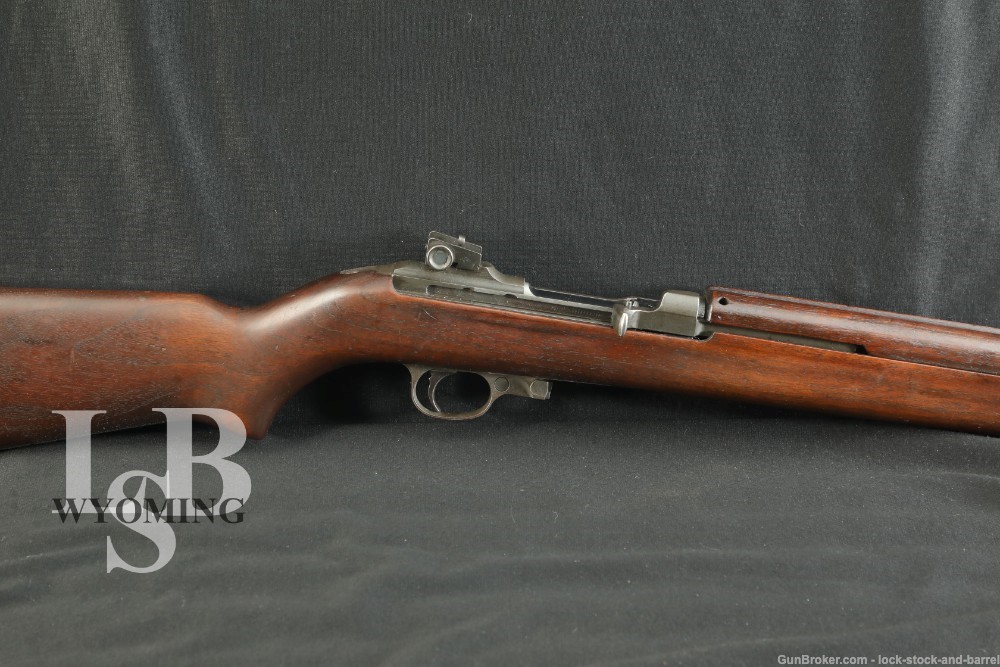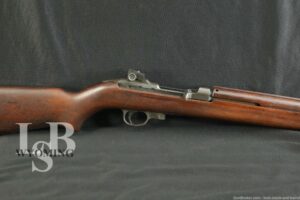
WWII Quality Hardware & Machine M1 Carbine .30 Cal Semi-auto Rifle 1943-44
SOLD FOR: $1,400.00
WOA#: WY240408WM021
Make: Quality Hardware & Machine Co.
Model: M1 Carbine
Serial Number: 4773489
Year of Manufacture: Receiver Late 1943 early 1944, Barrel Date 1-1944
Caliber: .30 Carbine
Action Type: Semi-Automatic, fed by detachable magazines.
Markings:
The top-rear of the receiver is marked “QUALITY H.M.C.”, and “4773489”.
The top-front of the receiver is marked “U.S. Carbine”, “CAL .30 M1”.
The barrel is marked with a “P” about mid length, toward the muzzle is marked “INLAND MFG. DIV. / GENERAL MOTORS / 1-44”. The barrel flat is stamped with many overlapping numbers and letters.
The front sight is marked “POQ” for Prestole Div. of International Harvester CO.
The rear sight is marked with a Shield “H” for Hemphill MFG CO.
The magazine release button is unmarked.
The receiver block in the stock is unmarked.
The inside of the upper handguard is marked “Q-RMC”. For Rock-Ola music company made for QHMC 2 rivet style.
The hammer is marked “LT-Q” for Ludlow Typograph made for QHMC.
The trigger group is marked “NL-Q” for National Lock Co, made for QHMC.
The right side of the stock is marked with an ordinance wheel.
The stock is marked “Q-RMC” for Rock-Ola music Co. made for QHMC.
The barrel band is marked “M-R” for Rock-Ola type 1 band
Barrel Length: 18″
Sights / Optics: The front sight is a fixed blade set between protective ears. The rear sight is the later style sliding aperture sight with a serrated windage knob dovetailed to the receiver.
Stock Configuration & Condition: The stock is a 2 high-wood with oval sling cut and a 2-rivet upper handguard, Type I barrel band, and a checkered metal butt plate. This rifle also has the early style cross bolt safety. The LOP measures about 13” from the front of the trigger to the back of the stock. The stock shows mostly minor compressions and surface scratches scattered throughout with two notable scratches on the right side next to the ordnance wheel, some chips and marring on the right side of the nose near the barrel band, and a small chip from the pommel. The upper handguard shows virtually no real signs of wear. The metal buttplate has lost its finish and has turned brown with patina. There are no visible cracks. Overall the stock is in Good to Very Good condition for C&R.
Magazine Quantity & Condition: None.
Type of Finish: Parkerized and Blued
Finish Originality: Original
Bore Condition: The bore is bright and the rifling is well defined. There is no visible erosion in the bore. There are some lines in the grooves from use. In this writer’s opinion the bore rates 8/10.
Overall Condition: This rifle retains about 90% of its metal finish. The balance of the metal surfaces have begun to turn or have turned brown with patina. The majority of the finish loss is on the friction surfaces of the receiver, the blued bolt, the trigger guard, the edge of the barrel step, and the edges of the front sight. The screw heads are sharp and the markings are clear. Overall this rifle is in Very Good Condition for C&R.
Mechanics: The action functions correctly. We did not fire this rifle. As with all used firearms, a thorough cleaning may be necessary to meet your maintenance requirements.
Box, Paperwork & Accessories: None.
Our Assessment: During the early stages of World War II, the U.S. military recognized the need for a lightweight rifle that would bridge the gap between the heavy and cumbersome M1 Garand rifle and the standard issue sidearm, the M1911 pistol. The goal was to provide troops with a compact and easy-to-handle firearm that offered more firepower than a pistol but was lighter and more maneuverable than a full-size rifle.
In 1941, the U.S. Army’s Ordnance Department contracted with various manufacturers, including Winchester, IBM, and General Motors’ Inland Division, and Quality Hardware and Machine to develop and produce the M1 Carbine. The rifle was designed by a team led by firearms designer David Williams, who drew inspiration from the successful M1 Garand and the short-recoil action of the M1 Thompson submachine gun. The M1 Carbine featured a gas-operated, semi-automatic action and fired a .30 caliber cartridge known as the .30 Carbine. The cartridge, while less powerful than the standard .30-06 ammunition used in the M1 Garand, offered greater capacity and reduced recoil, making it more controllable and well-suited for short to medium-range engagements.
The M1 Carbine saw widespread use in World War II, becoming a staple firearm for American troops. It was praised for its reliability, ease of use, and versatility. The rifle was not only issued to U.S. forces but also provided to allied nations through various lend-lease programs.
This example of a Quality Hardware & Machine Co. 1944 M1 carbine features many unique parts from companies including the Inland division of General Motors, International Harvester CO known for making M1 Garands, Ludlow Typograph Co. and Rock-Ola Music Co. mostly known for making Juke boxes. Please see our photos and best of luck with your bidding!!!-R.L.

